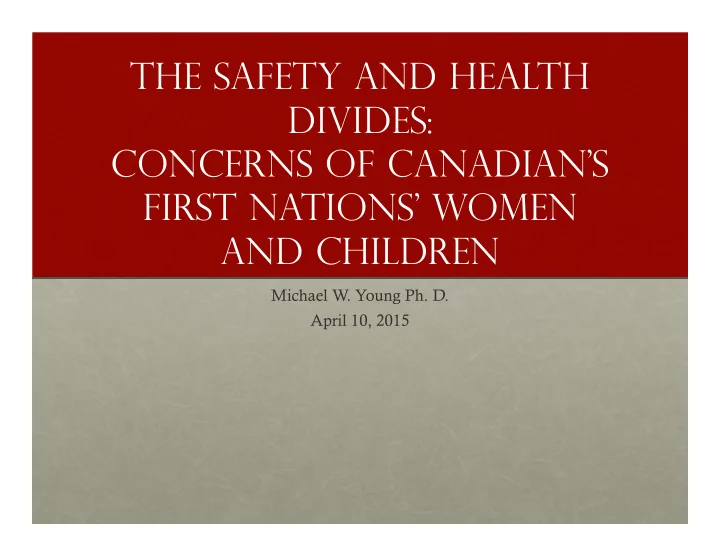

The Safety and Health Divides: Concerns of Canadian's First Nations' Women and Children Michael W . Young Ph. D. April 10, 2015
Background on Canadian native Issues In Canada, there are three major Aboriginal groups: The First Nations – officially 618 communities like the Cree, Mohawk, Birdtail Sioux, and many more The Metis – descendants of both aboriginal and European ancestors, mainly French Catholic The Inuit – who have had a home province in Nunavut since 1999 The Federal Government has an Aboriginal Affairs and Northern Development Department https://www.aadnc-aandc.gc.ca/
Current Map ( Denm ark) A r ct i e c l c C Beaufort ir Resolute Baffin ir C Sea Banks c Alaska l ic e I Bay t c ( USA) r A Davis Strait Baffin Island Inuvik Vict oria Dawson Great M I sland Gjoa a Bear c k e n z Lake Haven ie Yukon W h it e h or se I qaluit Northwest Labr ador N u n a v u t Territories Sea Baker A t l a n t i c R ive Lake Yellow knife r Ungava N Fort e w O c e a n f o u Nelson nd Great C A N A D A Bay l a Slave Lake nd Nain British a n d Kuujjuaq Fort L Columbia ab McMurray Churchill r Hu dson a Prince d Falls o George r Churchill Bay Alberta St John’s P a ci f i c n Sept -Îles a w Manitoba Edm onton e h e è r tc v i R i d e n Saint-Pierre et Miquelon a L Winnipeg a G r k a James L s Vancouver (France) R e Sandy v r a K i e S r a s a F m Calgary r Bay Quebec l Lake o o p Prince Edward Island s Saskatoon Victoria Charlottetow n New Brunswick O ce a n W innipeg Ontario Québec Regina Nova Scotia Thunder F U r H ni Bay e t a ed d l LEGEND i f S e a Montréal x t a r t i e c s t o f o A n m e r i c a National capital Ottaw a A t l a n t i c Lake Provincial or Territorial capital Superior Toronto Other populated places O c e a n
Health Care Controversies for the Aboriginal peoples • First Peoples, Second Class Treatment • A study released in Feb. 2015 by the Wellesley Institute • The study says well-documented disparities in aboriginal and non-aboriginal health are rooted in colonial government policies, such as segregation and Indian residential schools. • The study suggests aboriginal people experience racism from health-care workers so frequently that they often strategize on how to deal with it before visiting emergency departments, or avoid care altogether.
Special Concerns for the Children • The Universal Declaration of Human Rights states: "Everyone has the right to a standard of living adequate for the health of himself and of his family, including food, clothing, housing and medical care and necessary social services” I have realized that in Canada these rights are upheld only if you are non-indigenous in Canada. Today, in our land of plenty, indigenous children suffer malnutrition and many are actually starving. Hundreds of indigenous communities lack clean water and adequate housing. Indigenous children receive less funding for education per child than their non-indigenous counterparts. Many indigenous women and girls don’t live in safety. - column posted by the CBC.ca • Dr. Anna Banerji is the Director of Global and Indigenous Health, for Continuing Professional Development, for the Faculty of Medicine, University of Toronto • Photo – the Aggark children who live 12 a two bedroom house
Stress on the Inuit & First Nations • The last Inuit Health Survey found seven out of every 10 Inuit households in Nunavut are food insecure. That means they lack access to nutritious, affordable foods — despite government subsidies and programs to confront hunger. • This is a new medical textbook for these communities, to fill a gap in the health care curriculum, published just this year.
RCMP Report Released in May 2014 RCMP's National Operational Overview RCMP's National Operational Overview on Missing and Murdered Aboriginal on Missing and Murdered Aboriginal Women Women “The report found that aboriginal “The report found that aboriginal women account for 4.3 per cent of the women account for 4.3 per cent of the overall Canadian female population overall Canadian female population yet account for 16 per cent of female yet account for 16 per cent of female homicides and 11.3 per cent of the homicides and 11.3 per cent of the cases of missing women”- CBC News cases of missing women”- CBC News 1,181 murders and missing person 1,181 murders and missing person cases in three decades cases in three decades
Putting a Young Face to the Story • Tina Fontaine, a Sagkeeng • 15 year old runaway taken into custody by Children and Foster Services in Winnipeg, Manitoba • Found murdered in the Red River days later • Similar to Winnipeg cases of 16 year olds Felicia Osborne and Rinelle Harper (who survived an attack)
Charges of Indifference • National leaders, including Prime Minister Steven Harper (from the Conservative Party), resisting calls for more investigations of these open murder and missing cases • “Tina must not disappear into the oblivion of statistics”, Acting Chief Commissioner of Canadian Human Rights Commission Davis Langtry • “The murder of Tina Fontaine is a national tragedy”, Niki Ashton, member of Parliament (from the New Democrats)
Thank You for your Time
Recommend
More recommend